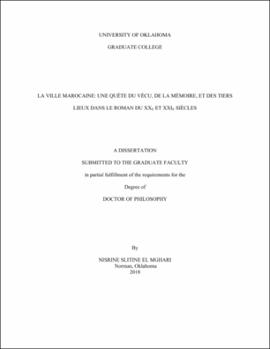| dc.description.abstract | Generally, work in the area of Moroccan literature treats Arabophone and Francophone texts as separate domains. My dissertation, entitled “La ville marocaine: une quête du vécu, de la mémoire, et des tiers lieux dans le roman du XXe et XXIe siècles,” remedies this state of affairs by bringing together texts in both languages. My research focuses on representations of the city in 20th- and 21st-century Francophone and Arabophone Moroccan literature. In more specific terms, my work concerns itself with the different social, historical, and political forces that, together, contribute to the construction of urban spaces, and it draws on various critical and theoretical fields, including cultural memory studies, gender studies, and literary studies, while at the same time considering different contemporary Moroccan urban structures from a spatio-temporal perspective. The first chapter of my dissertation offers an overview of the modern Moroccan city as it transitions from a space of holism and communal life in precolonial Morocco to one of ethnic division, ethical egoism, and materialism during the French Protectorate (1912 -1956). I subsequently look at the social segregations that persist in the postcolonial era, a period of disillusionment and disenchantment in modern Morocco, a nation-state characterized by social, religious, and political strife. To this end, I consider novels by 'Abdurrahīm Jīrān, Mahi Binebine, Muḥammad al-Ash'arī, Youssouf Amine Elalamy, and Youssef Jébri and draw on colonial and postcolonial writings of thinkers such as Frantz Fanon, Albert Memmi, and Hélé Béji. My second chapter addresses the city as a territory of individual and collective memory in literary works by Aḥmad al-Madīnī, Binebine, and Edmond Amran El Maleh. Here I examine various cultural monuments, including sanctuaries, city squares, gardens, songs, popular expressions, texts, and historical personalities, insofar as they function as lieux de mémoire according to Pierre Nora’s usage of the term. These components of Moroccan cultural heritage function as manifestations of history through memory, rooted both in material and immaterial figures, and constitute national identity. Finally, in my third chapter, I analyze novels by Zakya Daoud, Fatima Mernissi, and Malīka Mustaḍraf and the way in which they portray the emergence of what Janet Abu-Lughod calls a “semi-public” sphere, a space of everyday social practice for men and women in the Islamic city. This space arises as the result of women leaving the private sphere to which they were generally limited in order to participate in the public sphere—typically defined as a male realm in Moroccan society. Although some women writers employ this concept of “the third space” to illustrate an accessible territory in constant movement, others resort to it to depict a space of clashes and, at times, transgression. | en_US |
